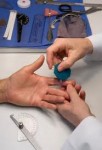
Hand Therapy is a specialty of both the Occupational and Physical Therapy professions that has become an area of expertise on its own. To date, there are over 5,000 therapists in the U.S. with a title of Certification in Hand Therapy (CHT). This includes 86%% of which are Occupational therapists and 14% are Physical therapists.(1) The requirements include working a minimum of five years of clinical experience, with 4,000 hours in direct hand therapy practice and passing a thorough exam involving advanced competency in the upper quadrant rehabilitation.
Hand therapy is the art and science of rehabilitation of the upper limb, which includes the hand, wrist, elbow and shoulder girdle. It is a merging of occupational therapy and physical therapy theory and practice that combines comprehensive knowledge of the structure of the upper limb with function and activity. Using specialized skills in assessment, planning and treatment, hand therapists provide therapeutic interventions to prevent dysfunction, restore function and/or reverse the progression of pathology of the upper limb in order to enhance an individual’s ability to execute tasks and to participate fully in life situations.(2)
The title of CHT allows the patient to have confidence that they are getting the most up to date and comprehensive treatment in rehabilitation of their hands. This includes a mandatory recertification process every five years of continuing education and hours of direct practice submitted for approval to maintain their CHT status.
Hand surgery is a very specialized area of orthopedic practice. The detailed anatomy of the hand and upper extremity often requires complex surgical repairs. The outcome is determined by not only the surgery but the post- operative care and rehabilitation. It is imperative that the therapist has advanced skills and stays current in the latest surgical as well as hand therapy techniques.
 Our hands are so powerful in defining who we are, what we do, and how we find purpose and meaning in our lives. It can be very life-altering when a patient sustains an injury to their hands. As Occupational therapists, specializing in Hand therapy brings our role as OTs into helping patients achieve maximum recovery of their hands to meet their specific functional goals. It is a privilege to be a part of their team and a great responsibility to provide the utmost skill and advanced level of care in their rehabilitation.
Our hands are so powerful in defining who we are, what we do, and how we find purpose and meaning in our lives. It can be very life-altering when a patient sustains an injury to their hands. As Occupational therapists, specializing in Hand therapy brings our role as OTs into helping patients achieve maximum recovery of their hands to meet their specific functional goals. It is a privilege to be a part of their team and a great responsibility to provide the utmost skill and advanced level of care in their rehabilitation.
Becoming a CHT is voluntary, and a long term professional commitment. It is arduous in its standards, as it should be. CHTs are dedicated to achieving and maintaining the highest standards of their profession. It is a certification in healthcare that is recognized in the medical community as an exemplary standard of practice in the field of hand therapy.
Addendum: As a precursor to attaining a CHT designation, you can apply for Advanced Practice in OT through the California Board of Occupational Therapy (CBOT). Legislation was passed in 2003 that requires OTs offering services in hand therapy to show competence. Courses and experience must fall within 5 years immediately preceding application. Requirements include a minimum of 45 contact hours of education and training and a minimum of 480 hours in supervised hand therapy. (3)
References:
(1) Hand Therapy Certification Commission (HTCC) website, October 2012.
(2) HTCC Board of Directors adopted this definition in March 2009.
(3) California Board of Occupational Therapy

